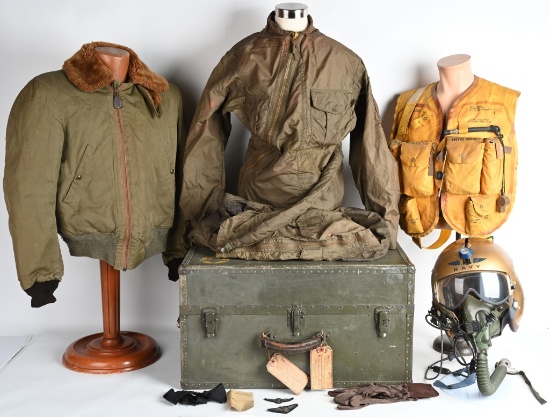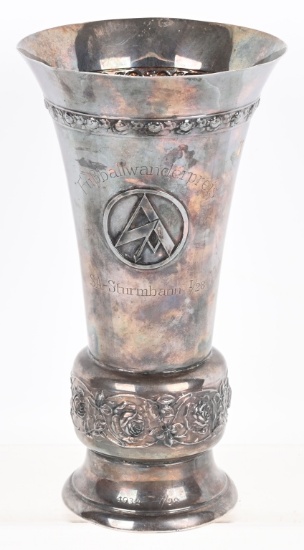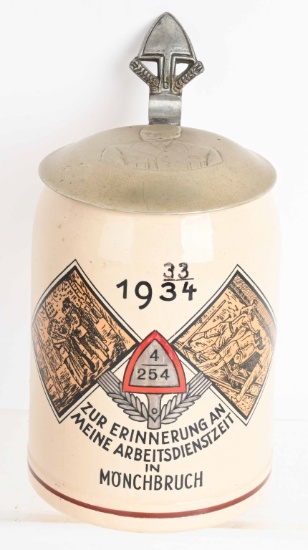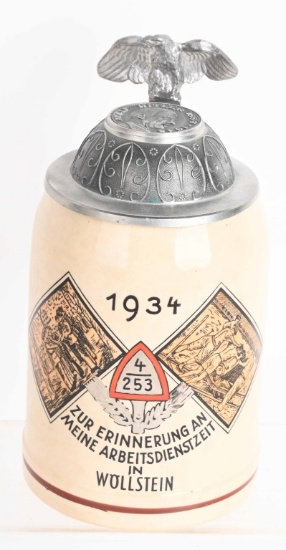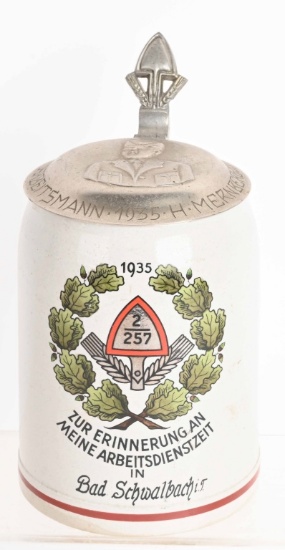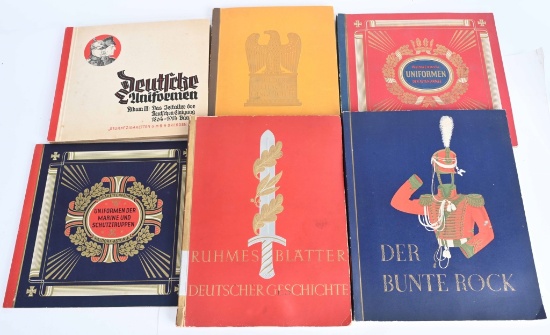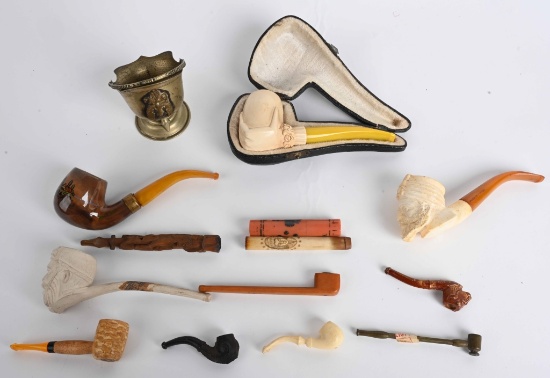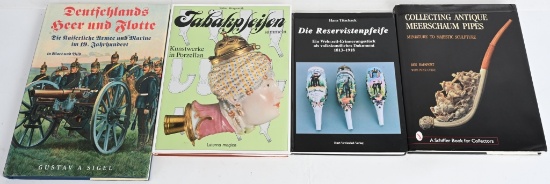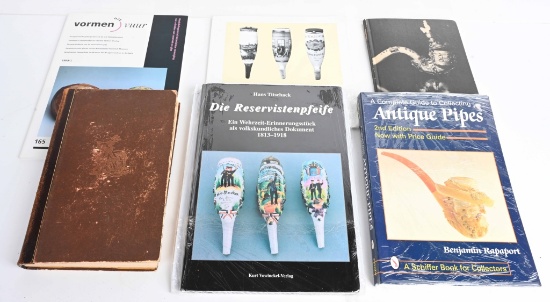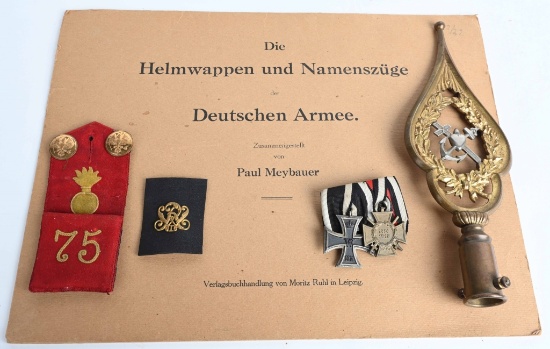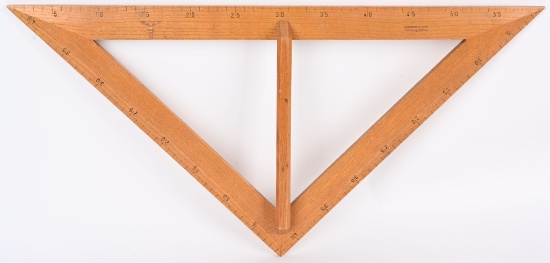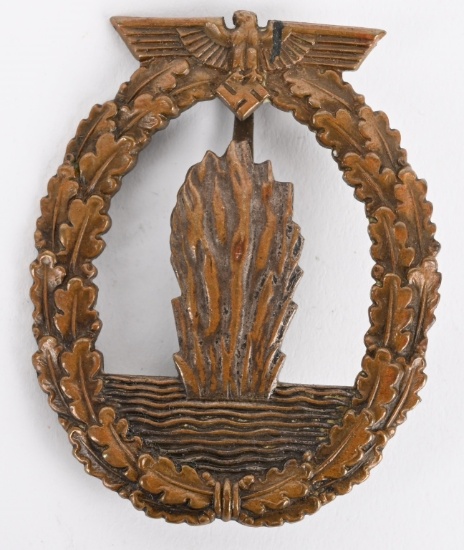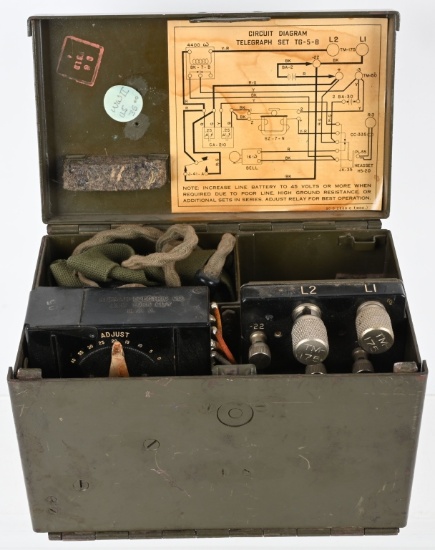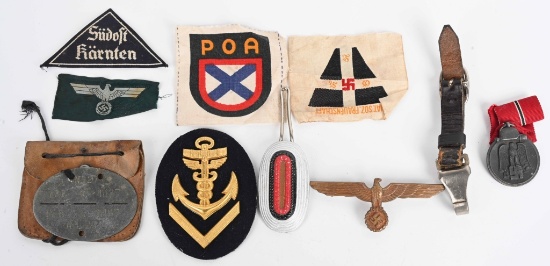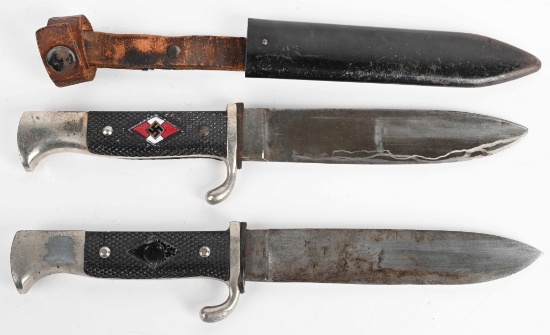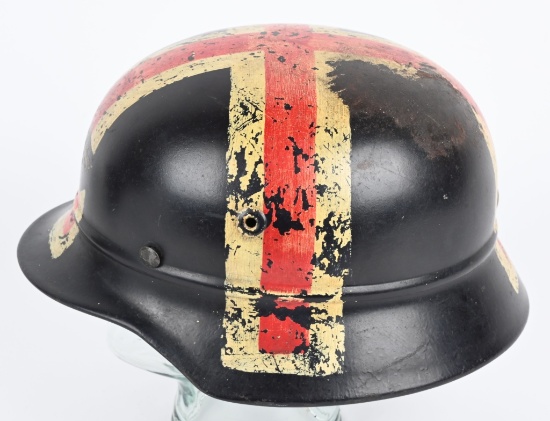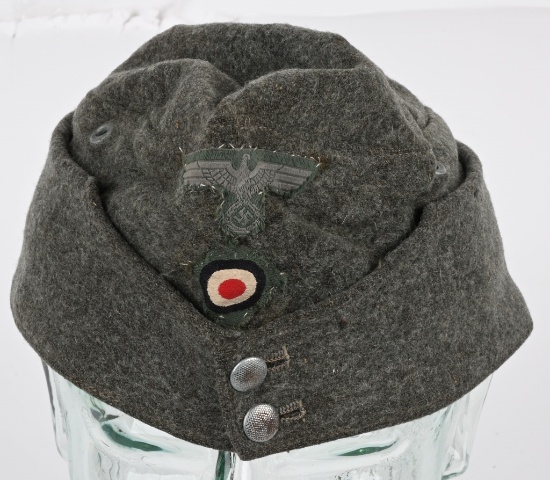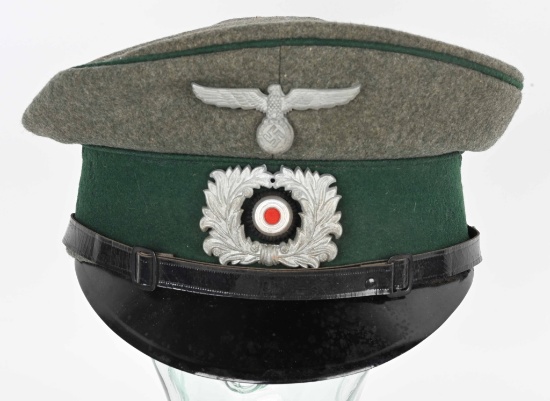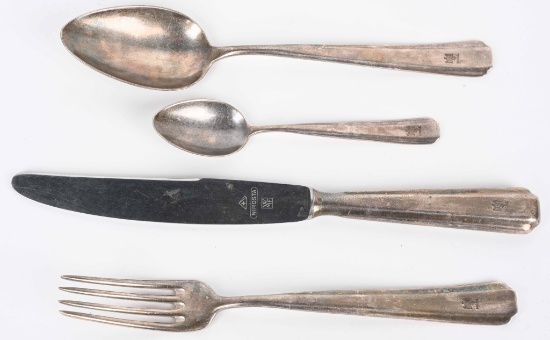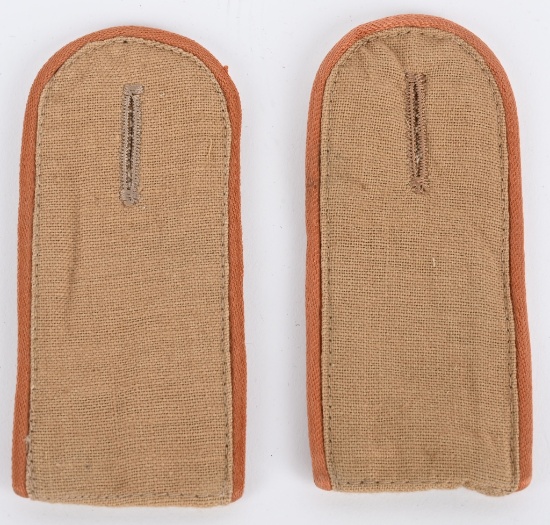Lot # 284 (Sale Order: 294 of 874)
Low Estimate: 300High Estimate: 400
WWII Nazi German Hitler Youth Camp Knife Lot To Include 1) HJ camp knife, has a roughly, 5 1/8", (13 cm), long, drop forged, steel construction, single edged, non-fullered, nickel/silver plated, blade and a full length, including the hilt of roughly, 9 1/4", (23.6 cm) with some minor sharpening. Maker marked M7/56 indicating manufacture by C.D. Schaaf of Solingen. The blackened leather washer is still intact. The tooled steel construction hilt features a single, up-swept, cross guard arm and a stylized eagle head pommel. The knife has molded, black, diamond grooved, Bakelite grips with dual, small, dome headed, alloy retaining rivets fully intact. The obverse grip has an imbedded enameled and silver washed alloy HJ diamond. The HJ diamond features red enamel top and bottom quarters and white enamel side quarters with a central, canted, black enamel swastika. The diamond has the correct translucent red enamel with a pebbled field visible underneath. The knife comes with it’s original magnetic sheet metal scabbard. Straps and snap are all complete but there is a period repair to the backstrap. 2) HJ camp knife, 5 1/8", (13 cm), long, drop forged, steel construction, single edged, non-fullered, nickel/silver plated, blade and a full length, including the hilt of roughly, 9 1/4", (23.6 cm). Maker marked M7/40 indicating manufacture by Hartkopf & Co. Solingen. The blackened leather washer is still intact. The tooled steel construction hilt features a single, up-swept, cross guard arm and a stylized eagle head pommel. The knife has molded, black, diamond grooved, Bakelite grip to the obverse with dual, small, dome headed, alloy retaining rivets fully intact. The reverse is missing the Bakelite grip. The origins of the Hitler Jugend, (Hitler Youth), may be traced back to March 1922 with the formation of the Jugendbund der NSDAP, Nationalsozialistische Deutsche Arbeiterpartei, (Youth League of the National Socialist German Worker’s Party), under control of the SA, Sturm Abteilung, (Storm/Assault Detachment). In April 1924 the Jugendbund der NSDAP was renamed Grossdeutsche Jugendbewegung (Greater German Youth Movement), and on July 4TH 1926 the Grossdeutsche Jugendbewegung was officially renamed Hitler Jugend Bund der deutschen Arbeiterjugend, (Hitler Youth League of German Worker Youth). The HJ Fahrtenmesser, (Hike/Camp knife), was introduced in early 1933 and was the first blade sidearm to be officially sanctioned by the NSDAP. Of Note: Although the HJ camp knife was the first, officially sanctioned, blade, side arm the SA dagger was the first, officially sanctioned, dagger. Originally the camp knife was intended for wear by all HJ members regardless of rank but in 1937 a presentation Leader’s dagger was introduced for wear by the ranks of Gefolgschaftsführer to Reichsjugendführer and the camp knife was relegated for wear by the ranks of Hauptgefolgschaftsführer and below. An additional NSDAP party formation, the DJ Deutsche Jugend, (German Youth), with members, aged 10-14, were also permitted wear of the HJ camp knife. The distribution of the HJ camp knife was controlled by the NSDAP and was dependant on the recipient successfully completing the appropriate proficiency requirements and tests. After meeting the requirements the individual was still responsible for purchasing the HJ camp knife through official channels. Regulations stated that the HJ camp knife was only to be worn while the recipient was in uniform, although it is highly doubtful that young boys/men adhered to these regulations unless they were strictly enforced. Originally the HJ camp knives had a blade inscription with the HJ motto, "Blut und Ehre!", (Blood and Honor), inscribed in a facsimile of the HJ Reichsjugendführer, (Hitler Youth National Youth Leader), Baldur von Schirach’s handwriting, but in August 1938 the blade inscription was discontinued. Of Note: The HJ was an official NSDAP formation and as a result it’s uniforms and equipment items fell under the authority of the RZM, Reich Zeug Meisterei, (National Equipment Quartermaster). The RZM, was officially founded in June 1934 in Munich by the NSDAP, as a Reich Hauptamt, (State Central Office), and was based on the earlier SA Quartermaster’s Department. The functions of the RZM were not only to procure and distribute items to Party formations, including the HJ, but also to approve chosen designs and to act as a quality control supervisor to ensure items manufactured for Party formations met required specification and were standardized. Uniforms and equipment items manufactured for the HJ came under the quality control of the RZM and were generally marked by the appropriate RZM approval/acceptance markings. Further production of the HJ camp knives was official discontinued in October 1942.
WWII Nazi German Hitler Youth Camp Knife Lot To Include 1) HJ camp knife, has a roughly, 5 1/8", (13 cm), long, drop forged, steel construction, single edged, non-fullere
...mored, nickel/silver plated, blade and a full length, including the hilt of roughly, 9 1/4", (23.6 cm) with some minor sharpening. Maker marked M7/56 indicating manufacture by C.D. Schaaf of Solingen. The blackened leather washer is still intact. The tooled steel construction hilt features a single, up-swept, cross guard arm and a stylized eagle head pommel. The knife has molded, black, diamond grooved, Bakelite grips with dual, small, dome headed, alloy retaining rivets fully intact. The obverse grip has an imbedded enameled and silver washed alloy HJ diamond. The HJ diamond features red enamel top and bottom quarters and white enamel side quarters with a central, canted, black enamel swastika. The diamond has the correct translucent red enamel with a pebbled field visible underneath. The knife comes with it’s original magnetic sheet metal scabbard. Straps and snap are all complete but there is a period repair to the backstrap. 2) HJ camp knife, 5 1/8", (13 cm), long, drop forged, steel construction, single edged, non-fullered, nickel/silver plated, blade and a full length, including the hilt of roughly, 9 1/4", (23.6 cm). Maker marked M7/40 indicating manufacture by Hartkopf & Co. Solingen. The blackened leather washer is still intact. The tooled steel construction hilt features a single, up-swept, cross guard arm and a stylized eagle head pommel. The knife has molded, black, diamond grooved, Bakelite grip to the obverse with dual, small, dome headed, alloy retaining rivets fully intact. The reverse is missing the Bakelite grip. The origins of the Hitler Jugend, (Hitler Youth), may be traced back to March 1922 with the formation of the Jugendbund der NSDAP, Nationalsozialistische Deutsche Arbeiterpartei, (Youth League of the National Socialist German Worker’s Party), under control of the SA, Sturm Abteilung, (Storm/Assault Detachment). In April 1924 the Jugendbund der NSDAP was renamed Grossdeutsche Jugendbewegung (Greater German Youth Movement), and on July 4TH 1926 the Grossdeutsche Jugendbewegung was officially renamed Hitler Jugend Bund der deutschen Arbeiterjugend, (Hitler Youth League of German Worker Youth). The HJ Fahrtenmesser, (Hike/Camp knife), was introduced in early 1933 and was the first blade sidearm to be officially sanctioned by the NSDAP. Of Note: Although the HJ camp knife was the first, officially sanctioned, blade, side arm the SA dagger was the first, officially sanctioned, dagger. Originally the camp knife was intended for wear by all HJ members regardless of rank but in 1937 a presentation Leader’s dagger was introduced for wear by the ranks of Gefolgschaftsführer to Reichsjugendführer and the camp knife was relegated for wear by the ranks of Hauptgefolgschaftsführer and below. An additional NSDAP party formation, the DJ Deutsche Jugend, (German Youth), with members, aged 10-14, were also permitted wear of the HJ camp knife. The distribution of the HJ camp knife was controlled by the NSDAP and was dependant on the recipient successfully completing the appropriate proficiency requirements and tests. After meeting the requirements the individual was still responsible for purchasing the HJ camp knife through official channels. Regulations stated that the HJ camp knife was only to be worn while the recipient was in uniform, although it is highly doubtful that young boys/men adhered to these regulations unless they were strictly enforced. Originally the HJ camp knives had a blade inscription with the HJ motto, "Blut und Ehre!", (Blood and Honor), inscribed in a facsimile of the HJ Reichsjugendführer, (Hitler Youth National Youth Leader), Baldur von Schirach’s handwriting, but in August 1938 the blade inscription was discontinued. Of Note: The HJ was an official NSDAP formation and as a result it’s uniforms and equipment items fell under the authority of the RZM, Reich Zeug Meisterei, (National Equipment Quartermaster). The RZM, was officially founded in June 1934 in Munich by the NSDAP, as a Reich Hauptamt, (State Central Office), and was based on the earlier SA Quartermaster’s Department. The functions of the RZM were not only to procure and distribute items to Party formations, including the HJ, but also to approve chosen designs and to act as a quality control supervisor to ensure items manufactured for Party formations met required specification and were standardized. Uniforms and equipment items manufactured for the HJ came under the quality control of the RZM and were generally marked by the appropriate RZM approval/acceptance markings. Further production of the HJ camp knives was official discontinued in October 1942.less...



 x Cancel
x Cancel
